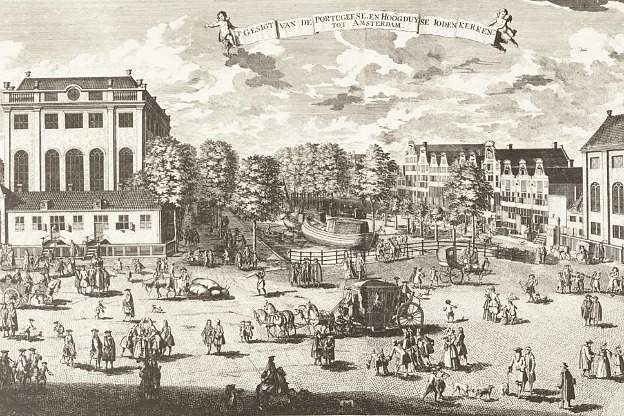
The Inquisition
In the Spanish-Jewish dialect of Ladino spoken by Sephardic Jews, Esnoga is the word for synagogue. The Esnoga built in the Amsterdam in 1675 was constructed to house a large congregation of Spanish and Portuguese Jews who came to the new Dutch Republic seeking shelter from persecution, forced conversion, and the Inquisition. In their new homeland the Sephardim found greater tolerance and religious freedom, and in their new house of worship a place to rebuild traditions and community.
Etz Hayim Library
As it became more and more established, the Amsterdam Esnoga amassed a notable library, the Etz Hayim library. The holdings there have preserved a rich and valuable source for music spanning several centuries, and it’s this library from which comes many of the compositions heard on a recent Centaur release recorded by the Apollo Ensemble. Selections on the disc include the cantata "Le-el Elim," composed for the Amsterdam congregation by Abraham Caceres in 1738 on the occasion of Simchat Torah.
Reconstructing the Music
The Caceres cantata is found in complete form in the Ets Haim library, however, there are many fragmentary, incomplete, and unpublished scores in the collection as well. An 18th century work written by a composer named Mani is one of these incomplete works, with only bits and pieces surviving. Ton Koopman, harpsichordist and director of the Amsterdam Baroque Orchestra, reconstructed and arranged this piece, and several others like it, for this recording. Koopman’s work admittedly relies on a good dose of conjecture and imagination. We can never really know what was originally heard—but the version on this recording, is nonetheless delightful.
Giacobbe Basevi Cervetto
Along with vocal pieces by unfamiliar composers, there are others, not necessarily represented in the Ets Haim library, that round out this disc including nice performances from the Apollo Ensemble of instrumental sonatas for two violins by Salomon Rossi, as well as a sonata by Mario Uccellini titled “La Ebrea Marinata.” There’s also a lovely cello sonata by Giacobbe Basevi Cervetto, an Italian cellist and composer of Sephardi Jewish origin who made his career in mid-18th c. England. It’s thanks in part to Cervetto that the cello became popular as a solo instrument in England during the period of transition from the Baroque era to the Classical style.
Yaniv d’Or and Ensemble Naya
In a very different recording, Israeli countertenor Yaniv d’Or and Ensemble Naya have also explored Sephardism and its musical heritage. Produced on their own label, Ensemble Naya’s recording is titled Liquefacta est, taken from the Song of Solomon text ‘Anima mea liquefacta est ut locutus est’ (My soul melted when he spoke). The longing words have inspired many musical settings in both Jewish and Christian traditions—one included on this recording is by Claudio Monteverdi.
The bulk of this program, however, wanders further afield with works like an anonymous 16th tune with connections to Iraq: Lecha Eli T’shukati (to you O God is my longing). The song is performed here with a Turkish lute (the oud), percussion and sitar.
In addition to the religious works, the the remainder of this CD is devoted to secular songs of love and yearning sung in Ladino.









